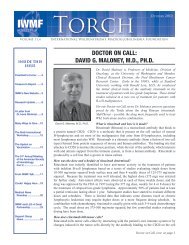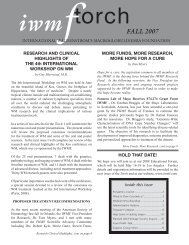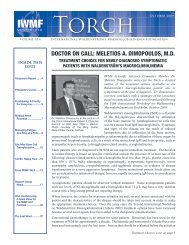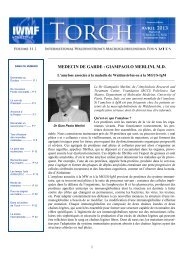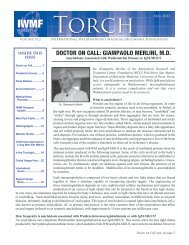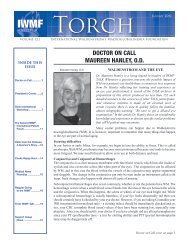English - International Waldenstrom's Macroglobulinemia Foundation
English - International Waldenstrom's Macroglobulinemia Foundation
English - International Waldenstrom's Macroglobulinemia Foundation
You also want an ePaper? Increase the reach of your titles
YUMPU automatically turns print PDFs into web optimized ePapers that Google loves.
Letter to the Editor<br />
Each issue of the Torch invites readers to “Have your say” by sending letters, articles, or suggestions for articles to<br />
the editor of the newsletter. Recently the Torch received a letter from Raphael Altman, an IWMF member in England,<br />
outlining what he perceived to be disinterest in IWMF publications and in the medical community at large concerning<br />
the rare occurrence of tumors in WM. This letter is printed in full below. The response which follows was written by Dr.<br />
Robert A. Kyle, IWMF Trustee and Chairman of the IWMF Scientific Advisory Committee.<br />
Alice Riginos<br />
Torch Editor<br />
Dear Editor,<br />
I am addressing the topic: WM, Tumors, and the IWMF.<br />
I have surveyed IWMF-Talk and found that of 1,000<br />
members, 10 have solid tumors. That’s 1%. Eight of these<br />
ten have enough abnormal IgM to be diagnosed WM but<br />
not enough to be a problem. Steven Treon states, “Most<br />
cases of LPL are WM, with less than 5% of cases made up<br />
of IgA, IgG and non-secreting LPL.” (All WM patients<br />
have underlying LPL) People reporting on IWMF-Talk<br />
have had tumors on the spine, in the foot, in the mouth –<br />
it seems like they can appear anywhere.<br />
A word about words. Many doctors appear to be satisfied<br />
with the term ‘solid tumor’ to describe this phenomenon.<br />
Others suggest alternative terms such as ‘mass’ or even<br />
‘aggregations of lymph tissue cells.’ What we decide to<br />
call the condition is less important than the implications<br />
of having it.<br />
I have observed that there is currently no mention of<br />
it on the IWMF website. Nor is it mentioned in the<br />
‘Introduction to WM’ or ‘For the newly diagnosed’ or<br />
‘When to treat’ type of articles that have appeared in<br />
the Torch or in similarly-titled talks given at the annual<br />
Educational Forum. I believe this is an omission that<br />
stands to be corrected.<br />
Firstly, the simple acknowledgement of a form of the<br />
disease affecting probably 1+% of patients would seem<br />
to be reasonable. Secondly, particular observations – and<br />
even suggested treatments? – relating to this section of<br />
patients might then have a greater chance of appearing<br />
on the WM radar. Thirdly, patients who might only<br />
monitor their IgM as a disease indicator would be less<br />
likely to make the mistake of thinking that good IgM<br />
readings alone are necessarily an indicator that all is well,<br />
when they could have indolent tumors quietly growing<br />
undetected.<br />
For example: my first tumour (6 cm), inside the spinal<br />
column, was spotted because at diagnosis I presented<br />
with some back pain and was scanned. My second tumour<br />
(12 cm), on the outside of the spine, was missed, possibly<br />
for as long as 2 years, because my IgM counts continued<br />
to be fine and dandy. (It was eventually spotted because<br />
I started to experience a similar, albeit mild, back pain)<br />
Risks of extra exposure to radiation notwithstanding, the<br />
dominant view among those on IWMF-Talk with tumors<br />
appears to be to scan at diagnosis and/or whenever<br />
unexplained pains might warrant scanning. Once<br />
someone has had a tumor, occasional scanning to pick up<br />
anything untoward could be considered.<br />
As to the science of what is going on with these patients<br />
(let alone why this happens to particular individuals) there<br />
appears to be not a great deal available on the subject,<br />
presumably (and understandably) because researchers<br />
and clinicians are concentrating on the issues of elevated<br />
IgM which afflict the vast majority of patients.<br />
Accepting the caveat that there are areas where the clear<br />
distinction between B-cells and plasma cells becomes<br />
less clear and where it even becomes unclear as to which<br />
cells are proliferative and which are IgM secreting,<br />
nevertheless in his paper ‘Pathological findings in WM’<br />
Dr. Roger Owen writes “The dominant component is<br />
comprised of B-cells which are considered to be the<br />
proliferative fraction … the second cellular component<br />
comprises plasma cells which are responsible for the<br />
production of IgM.” Elsewhere he states: “The clinical<br />
features of WM will likely form a continuous spectrum<br />
with the high IgM / hyperviscosity patients at one end<br />
and the patients with bulky lymph node disease (and<br />
tumors? – RA) and low IgM at the other.”<br />
Raphael Altman<br />
England<br />
RESPONSE<br />
Mr. Altman has raised an important point about<br />
Waldenstrom’s macroglobulinemia. When one mentions<br />
“solid tumors,” the hematologist/oncologist thinks first of<br />
cancer of the lung, colon, prostate, breast, etc., while Mr.<br />
Altman is referring to a mass which consists of malignant<br />
lymphocytes and plasma cells that are identical to those<br />
seen in the bone marrow of patients with WM. The bone<br />
marrow, lymph nodes and spleen are the usual sites of<br />
WM, but in a small number of patients (approximately<br />
5%), masses or tumors of the malignant lymphocytes and<br />
plasma cells are found outside the bone marrow and the<br />
lymph nodes.<br />
Letter to the Editor, cont. on page 13<br />
12 IWMF TORCH Volume 11.2



